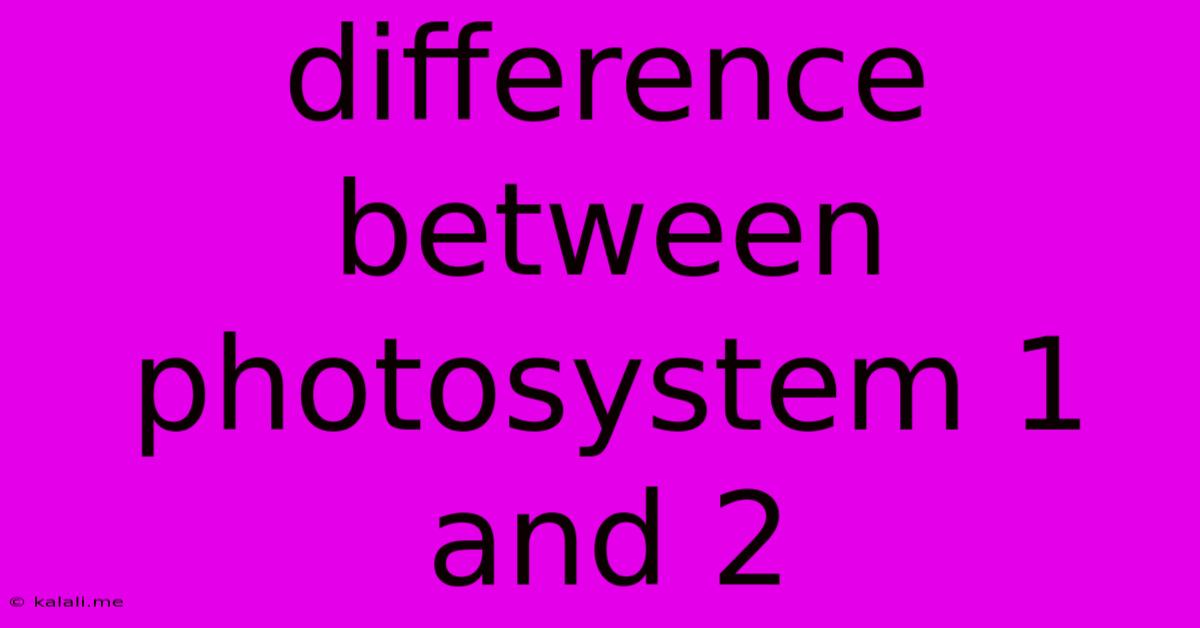Difference Between Photosystem 1 And 2
Kalali
Jun 12, 2025 · 3 min read

Table of Contents
Photosystem I vs. Photosystem II: Unraveling the Mysteries of Plant Photosynthesis
Photosynthesis, the remarkable process by which plants convert light energy into chemical energy, relies heavily on two crucial protein complexes: Photosystem I (PSI) and Photosystem II (PSII). While both systems play vital roles in the light-dependent reactions, they differ significantly in their function, location within the thylakoid membrane, and the specific wavelengths of light they absorb. Understanding these differences is key to comprehending the intricacies of plant life and its impact on the global ecosystem. This article will delve into the key distinctions between PSI and PSII, shedding light on their individual contributions to the photosynthetic process.
Differences in Function: The Electron Flow
The primary difference lies in their roles within the Z-scheme, the electron transport chain of photosynthesis. PSII initiates the process by absorbing light energy and using it to split water molecules (photolysis). This splitting releases electrons, protons (H+), and oxygen. The electrons are then passed along an electron transport chain, ultimately reaching PSI.
PSI, on the other hand, receives these electrons from PSII. It then absorbs more light energy, boosting the electrons to an even higher energy level. These high-energy electrons are then used to reduce NADP+ to NADPH, a crucial reducing agent used in the light-independent reactions (Calvin cycle) to synthesize carbohydrates. Therefore, PSII is responsible for the primary electron donation while PSI is responsible for the terminal electron transfer to NADP+.
Differences in Absorption Spectrum and Pigments
Both photosystems contain chlorophyll and accessory pigments, but their absorption spectra differ slightly. PSII primarily absorbs light at shorter wavelengths (around 680 nm), while PSI absorbs light at longer wavelengths (around 700 nm). This difference allows them to efficiently harvest a broader range of the visible light spectrum. The key chlorophyll molecules in each photosystem are named accordingly: P680 for PSII and P700 for PSI, reflecting their peak absorption wavelengths. This variation in absorption is crucial for maximizing light energy capture. The accessory pigments, such as carotenoids and phycobilins, further broaden the range of light absorbed and also protect the chlorophyll from photodamage.
Differences in Location within the Thylakoid Membrane
Although both photosystems are embedded within the thylakoid membrane of chloroplasts, their precise locations differ. While the exact spatial arrangement is complex and still being researched, PSII is generally found in the granal stacks of the thylakoid membrane, while PSI is predominantly located in the stromal lamellae, the unstacked regions connecting the grana. This spatial organization facilitates efficient electron transport between the two photosystems.
Differences in Associated Proteins and Cofactors
Beyond the core chlorophyll molecules, both photosystems are associated with a variety of proteins and cofactors that facilitate electron transport and other essential processes. These associated components vary between PSI and PSII, contributing to their functional distinctions. PSII, for example, contains the oxygen-evolving complex (OEC), responsible for water splitting, whereas PSI lacks this component. The differences in associated proteins also influence the regulation and efficiency of each photosystem.
Summary Table: Photosystem I vs. Photosystem II
| Feature | Photosystem II (PSII) | Photosystem I (PSI) |
|---|---|---|
| Primary Function | Water splitting, primary electron donation | NADP+ reduction, terminal electron transfer |
| Peak Absorption | ~680 nm (P680) | ~700 nm (P700) |
| Location | Grana thylakoids | Stromal lamellae |
| Key Components | Oxygen-evolving complex (OEC) | Ferredoxin, ferredoxin-NADP+ reductase |
| Electron Donor | Water | PSII |
| Electron Acceptor | Plastoquinone (PQ) | Ferredoxin (Fd) |
In conclusion, while both Photosystem I and Photosystem II are essential for the process of photosynthesis, they have distinct roles, structures, and locations within the chloroplast. Understanding these differences provides valuable insight into the efficiency and complexity of this fundamental biological process. Further research continues to unveil the intricate details of these vital components of plant life.
Latest Posts
Latest Posts
-
Which Of The Following Occurs In Meiosis But Not Mitosis
Jun 13, 2025
-
Which Of The Following Diseases Are Caused By Viruses
Jun 13, 2025
-
Density Of Water At 4 C
Jun 13, 2025
-
Words To Describe A Good Mom
Jun 13, 2025
-
Electron Volt Is A Unit Of
Jun 13, 2025
Related Post
Thank you for visiting our website which covers about Difference Between Photosystem 1 And 2 . We hope the information provided has been useful to you. Feel free to contact us if you have any questions or need further assistance. See you next time and don't miss to bookmark.